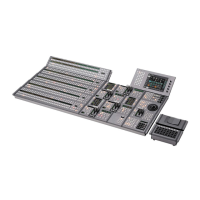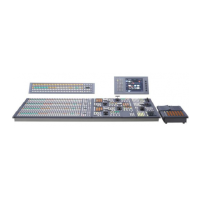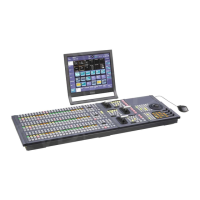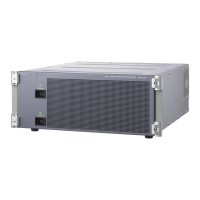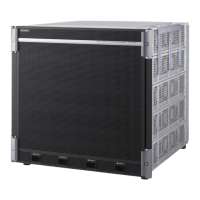13
Basic Video Processing
Chapter 1 Overview
Powerful frame memory functions
The frame memory can hold approximately 1000 frames in
an HDTV system (approximately 2000 frames in 720P/
59.94 format), approximately 5000 frames in an SDTV
system in 480i/59.94 format, or approximately 4000
frames in 576i/50 format, and allows eight frames to be
recalled simultaneously.
Multi viewer function
Equipped with two-system multi viewer function, as
standard, for displaying a window split into 10
subwindows or 4 subwindows.
Designed for use in a live broadcasting
environment
High-performance user interface
• An organic EL display with high visibility is used for the
source name displays.
• The buttons in the Multifunction Flexi Pad (hereinafter
called “Flexi Pad”) and transition control blocks use
color backlit LCD displays. The signal names, and
graphical representations of the patterns associated with
buttons provide intuitive feedback, and allow the
immediate decisions that are required in a live operating
environment.
Backup power supply
Equipped with two backup power supplies, as standard.
This alleviates the risk of power supply problems for
improved reliability during live operations.
Basic Video Processing
This section introduces basic functions used for video
processing on the switcher.
Transitions
In the M/E banks and PGM/PST bank, the switch from the
current video stream (appearing on the corresponding
program monitor) to a new video stream is referred to as a
transition.
In the M/E banks and PGM/PST bank, you can change one
of the images, the background, and keys 1 to 4
(downstream keys 1 to 4 in the PGM/PST bank), and also
vary combinations of these simultaneously.
The following are examples of transition.
Changing the background
A background transition switches from the video currently
selected on the background A bus (the current video) to the
video selected on the background B bus (the new video).
In the default selection of flip-flop mode (1 p. 56), the
background always switches in the direction from the A
bus to the B bus. When the transition completes, the cross-
point selections on the A and B buses are interchanged.
Inserting and deleting a key
You can insert one or more of the four keys (downstream
keys on the PGM/PST bank).
If you select a key which is already inserted, the transition
will delete the key.
A simultaneous combination of deleting and inserting keys
is also possible.
Inserting or deleting key 1 and key 2
Deleting key 1 and inserting key 2
Background A
Transition
Background B
Key 1
Delete
Insert
Key 2
Key 2
Key 1
Transition
